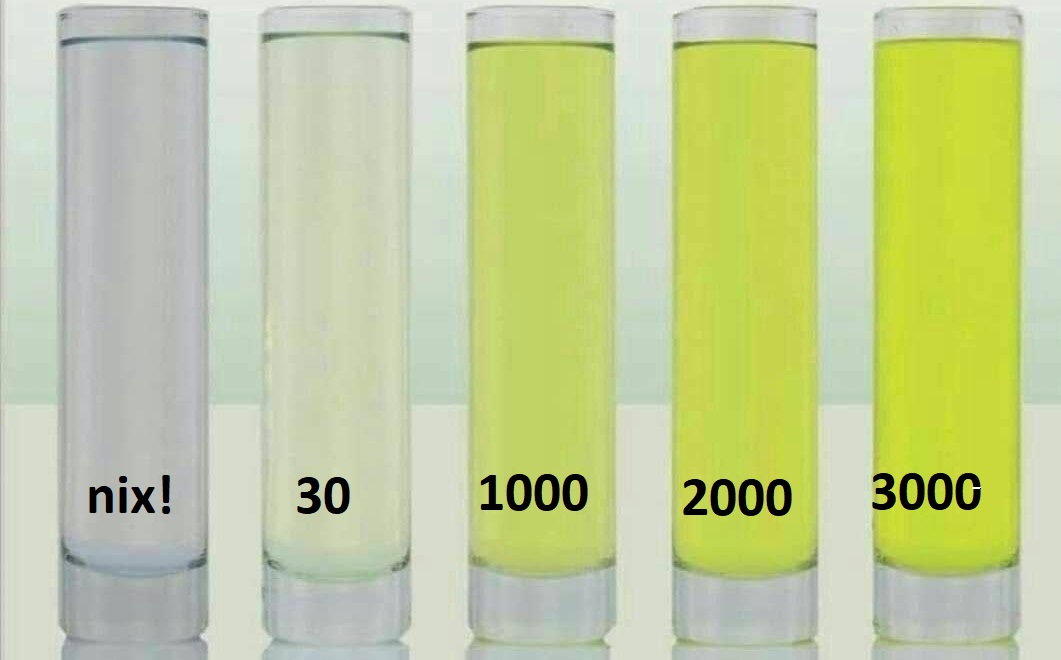How can you recognize a strong chlorine dioxide solution CDS/CDL 0.3%?
An important indicator that you can easily recognize is a pungent smell when you open the bottle and pour a small amount into a glass. This also automatically ensures that you do not inhale it for too long. Chlorine dioxide gas inhaled in large quantities can be dangerous. This gas displaces oxygen in the lungs. Excessive quantities can therefore lead to severe coughing.
Chlorine dioxide solution (CDS / CDS) and the yellow coloration
Another property of a strong chlorine dioxide solution (CDS / CDS) is that it has a strong yellow color.
The supplier, which is partly linked on my pages, always produces its chlorine dioxide solutions (CDH3000) fresh. The special production is something very special.

The color reproduction on the screen may differ. It is a deep yellow.
Experience in several groups showed that it had an even better effect than the strongly favored variant of CDS according to Andreas Kalcker. And I found this remarkable because I have long had the feeling that this specially acid-reduced variant has a stronger effect and is also better tolerated. If a quantity of 3 ml of chlorine dioxide solution in a glass with 250 ml of water burns the throat when swallowed, the solution is obviously over-acidified. A certain amount of acid stabilizes the solution, but often the amount of acid is too high.
Shelf life of chlorine dioxide gas solutions
Possible reasons for the rapid loss of concentration of a chlorine dioxide solution (CDL / CDS)
The bottle cap should be tight. This can be tested by placing the bottle upside down on the heater (do not overheat). Nothing should leak out. There should also be no smell of gas in the air.
Light is poison for a chlorine dioxide solution
Chlorine dioxide gas is generally sensitive to light. This does not just mean leaving it out in the sun, but also normal daylight. If the chlorine dioxide solution is used quickly, an amber glass bottle is perfectly adequate. Although the concentration drops slowly, this is not so important. However, if such a solution is stored in transparent clear glass or in blue glass bottles, the shelf life is considerably shorter than in amber glass bottles. A normal cupboard, for example, in which I place it on the lowest level, offers low-light storage. In general, a chlorine dioxide solution does not need to be refrigerated. You can find out why some people prefer this in the next paragraph.
Here you can get the chlorine dioxide solution I use CDH3000 in amber glass bottles. With the purchase via links, you support our work. Thank you for that…
Gas escapes when the bottles are opened
The escape of chlorine dioxide gas when opening and removing the solution from the bottle is another weak point in the shelf life of chlorine dioxide solutions. For this reason, many people prefer to store the solution in the refrigerator. This is because the gas is said to escape less quickly when cooled below 11 degrees Celsius because it is better bound in the water.
However, if the environment is warm, you can literally see the gas escaping in the warm air. So this is not a really good solution from my point of view. One supplier has thought about this and offers a largely closed dosing system for its chlorine dioxide solutions (CDH3000). The so-called “Doser system”. You no longer need a fridge, which is also much better if you want to use your solution on the go.
This Doser system reduces the hole in the bottle to the very small diameter of a syringe, which is part of the system. This reduction is achieved by the so-called Doser insert, which is available in 2 sizes, depending on which bottle size you are currently using.
The DIN18 size fits into small glass dropper bottles with a diameter of 18 mm. These usually have a volume of between 5 and 100 ml. The Doser system for PP28 offers a second size for larger bottles with a diameter of 28 mm, which are often found in bottles from 200 to 1000 ml. The amber glass bottles are also often referred to as medicine bottles.
The supplier I am linking to here also offers all CDL / CDS /CDH solutions with this specially designed dosing system. But you can also use your bottle with the doser system retrofitted.
Stop loss of concentration in the best possible way
This was once a dream. However, the loss of concentration and effectiveness of a chlorine dioxide solution can be reduced as much as possible if the following type of glass is used.
This is Mironglass. This is a violet glass that optimally blocks the radiation and external frequencies and protects your own frequencies in the solution.
Here you can find the optimal chlorine dioxide solution with a dosing system and in a here.
All love
Sebastian





